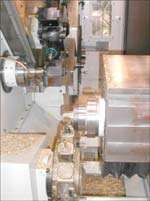One Lean, Mean, Metalcutting Machine
Increasingly, builders are responding to customer demands for part-processing flexibility and reduced part handling by designing machine tools capable of performing numerous operations within a single platform.
With a nod and a wink to the George Foreman grill, Hardinge Inc.'s new lean manufacturing cell (LMC) is designed to do for precision parts processing what the Foreman grill does for cooking meat—it gets the fat out. After a successful introduction at last fall's IMTS, Hardinge has ramped up production of its new multitasking machine badged as the Quest LMC 42.
Increasingly, builders are responding to customer demands for part-processing flexibility and reduced part handling by designing machine tools capable of performing numerous operations within a single platform. The LMC is no exception.
Featured Content
It is built to be a self-contained manufacturing cell that uses four distinct manufacturing zones to perform a variety of metalcutting operations. It's a "clean slate" design that takes proven component elements from conventional machine tools and configures them to enable complete part processing in a single handling.
Selecting a desired configuration allows a shop to run, in a single setup, a one-piece order or high-volume production lots from barstock or slugs. Intended for job shops and OEMs, the LMC concept applies principles of lean manufacturing—reduced operating expenses, reduced change-over time, reduced human intervention and waste—to maximize flexibility and throughput, thereby promoting the efficient manufacture of what's needed when it's needed.
As this figure shows, the LMC is comprised of four manufacturing zones within the working envelope of the machine tool. Zone 1 includes a fixed headstock, supporting bar work up to 1.625 inches (42 mm) in diameter with collets. For turning blanks, the spindle swings workpieces up to 4 inches (101.6 mm) in diameter with a step-jaw chuck. The headstock is paired with a 16-station VDI 25-mm vertical turret top plate that allows live tooling on all stations. The spindle has C-axis contouring as a standard feature, and the turret can be optionally equipped with Y-axis capability.
The Zone 2 chucking spindle can be used for primary or secondary operations. When used for primary operation, its three-axis (X, Y, Z) movement can be used for a variety of operations. Work handling automation is available to provide this spindle with load/unload capability for longer production runs. For secondary operations, this spindle has sufficient travel to pick off a workpiece from the Zone 1 spindle for backworking operations. In the Zone 2 workholding function, this spindle uses a B-42 stationary dead-length collet with a gripping capacity of 1.625 inches (42 mm). Machining with the three-axis spindle takes place in Zones 3 and 4.
Zone 3 is designed specifically for flexibility and ease of configuration. It can be equipped with a turret, a high-density gang tool plate, or the blank mounting surface can be used for a component customized to an application. The turret top plate used in this zone is the same configuration as the turret used in Zone 1 and can accommodate a range of turning, milling and drilling tools. Like the Zone 1 turret, live tooling is available on all stations. The fixed position, high-density gang tool plate accepts eight round shank tools up to 1-inch diameter and eight KM-32 modular quick-change tooling units. For customizing the blank tooling plate, Hardinge or the shop can customize a solution to a specific application need such as a B-axis attachment or a grinding head.
In Zone 4, KM-40 quick-change modular tooling is loaded and unloaded by an automatic toolchanger arm that services either a static tool station or optional live spindle from a 24-tool capacity carousel. The static tool station is used for conventional turning, drilling and boring operations. The live tooling option can do these traditional operations as well as milling.
The LMC uses the GE Fanuc 31i CNC that features a touchscreen PC-based front end. Hardinge has developed programming software to help develop a tool path and optimize the machine operation.
Progressively, machine tool design is migrating from specialized function to more flexible operations in the form of combining traditional stand-alone machining modules into a single machine platform. For the right application, the benefits for shops are reduced manufacturing costs and better throughput. Advances in the programmability and functionality of these machines can put shops into a better competitive position, which is not a bad idea these days.
RELATED CONTENT
-
Making Waves with Lathe Automation
After years of relying on an extensive machining cell for part production, this marine equipment manufacturer has now reduced part handling and improved quality through use of single-setup lathes and automated loading and unloading.
-
VIDEOS: Tips for Screw Making on Swiss-Type Machines
Here’s a three-part video series focused on Swiss screw making to help explain the benefits of thread whirling, back turning and broaching while taking into consideration CAM programming, tooling and machine specifications.
-
6 Tips for Training on a Swiss-Type Lathe
There are nuances to training a person to effectively operate a Swiss-type lathe. A shop I visited a while back offers some suggestions.









